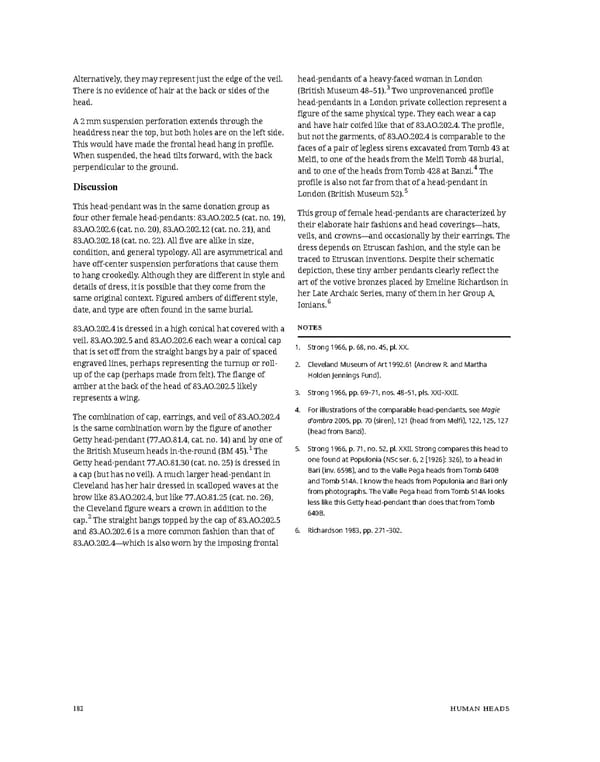Alternatively, they may represent just the edge of the veil. head-pendants of a heavy-faced woman in London There is no evidence of hair at the back or sides of the (British Museum 48–51).3 Two unprovenanced profile head. head-pendants in a London private collection represent a figure of the same physical type. They each wear a cap A 2 mm suspension perforation extends through the and have hair coifed like that of 83.AO.202.4. The profile, headdress near the top, but both holes are on the left side. but not the garments, of 83.AO.202.4 is comparable to the This would have made the frontal head hang in profile. faces of a pair of legless sirens excavated from Tomb 43 at When suspended, the head tilts forward, with the back Melfi, to one of the heads from the Melfi Tomb 48 burial, perpendicular to the ground. and to one of the heads from Tomb 428 at Banzi.4 The Discussion profile is also not far from that of a head-pendant in London (British Museum 52).5 This head-pendant was in the same donation group as This group of female head-pendants are characterized by four other female head-pendants: 83.AO.202.5 (cat. no. 19), their elaborate hair fashions and head coverings—hats, 83.AO.202.6 (cat. no. 20), 83.AO.202.12 (cat. no. 21), and veils, and crowns—and occasionally by their earrings. The 83.AO.202.18 (cat. no. 22). All five are alike in size, dress depends on Etruscan fashion, and the style can be condition, and general typology. All are asymmetrical and traced to Etruscan inventions. Despite their schematic have off-center suspension perforations that cause them depiction, these tiny amber pendants clearly reflect the to hang crookedly. Although they are different in style and art of the votive bronzes placed by Emeline Richardson in details of dress, it is possible that they come from the her Late Archaic Series, many of them in her Group A, same original context. Figured ambers of different style, Ionians.6 date, and type are often found in the same burial. 83.AO.202.4 is dressed in a high conical hat covered with a NOTES veil. 83.AO.202.5 and 83.AO.202.6 each wear a conical cap that is set off from the straight bangs by a pair of spaced 1. Strong 1966, p. 68, no. 45, pl. XX. engraved lines, perhaps representing the turnup or roll- 2. Cleveland Museum of Art 1992.61 (Andrew R. and Martha up of the cap (perhaps made from felt). The flange of Holden Jennings Fund). amber at the back of the head of 83.AO.202.5 likely 3. Strong 1966, pp. 69–71, nos. 48–51, pls. XXI–XXII. represents a wing. The combination of cap, earrings, and veil of 83.AO.202.4 4. For illustrations of the comparable head-pendants, see Magie is the same combination worn by the figure of another d’ambra2005, pp. 70 (siren), 121 (head from Melfi), 122, 125, 127 (head from Banzi). Getty head-pendant (77.AO.81.4, cat. no. 14) and by one of the British Museum heads in-the-round (BM 45).1 The 5. Strong 1966, p. 71, no. 52, pl. XXII. Strong compares this head to Getty head-pendant 77.AO.81.30 (cat. no. 25) is dressed in one found at Populonia (NSc ser. 6, 2 [1926]: 326), to a head in a cap (but has no veil). A much larger head-pendant in Bari (inv. 6598), and to the Valle Pega heads from Tomb 640B Cleveland has her hair dressed in scalloped waves at the and Tomb 514A. I know the heads from Populonia and Bari only brow like 83.AO.202.4, but like 77.AO.81.25 (cat. no. 26), from photographs. The Valle Pega head from Tomb 514A looks the Cleveland figure wears a crown in addition to the less like this Getty head-pendant than does that from Tomb cap.2 The straight bangs topped by the cap of 83.AO.202.5 640B. and83.AO.202.6is a more common fashion than that of 6. Richardson 1983, pp. 271–302. 83.AO.202.4—which is also worn by the imposing frontal 182 HUMAN HEADS
 Ancient Carved Ambers in the J. Paul Getty Museum Page 191 Page 193
Ancient Carved Ambers in the J. Paul Getty Museum Page 191 Page 193